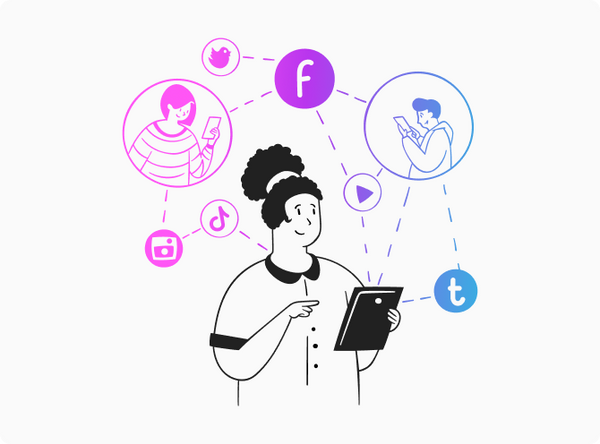
Behind every innovative solution is a team of project managers, programmers, and marketers, responsible for the key processes of product development. One of their responsibilities is to assess the risks and create an early version of a product (MVP) to validate it against the targeted audience.
That’s where MVP testing comes into play. For one, it allows you to check if the product you invest in is something that people are interested in. It can also prompt you in the direction of what can be improved for better interaction. More importantly, though, it can help you save time and money by showing you at an early stage whether it’s worth moving forward with the project or not.
In this article, we will take a look at twelve proven ways for testing an MVP that must be part of your validation checklist before launching a full-fledged project.
1. Landing Pages
It’s important for a landing page to include all the key information potential users need to determine that your product is different and better than the competitors. A landing page, even if it’s the only page on your website, may also act as a minimal viable product (MVP) for displaying services, if that is something you offer.
Make sure to use it strategically. The primary purpose of a landing page is to build a base of interested clients. But it can also be used to demonstrate your pricing plans or any other details that can help steer users to the point of purchase. Using analytics tools can help you identify which features are working to your advantage and which should be improved.
2. Bloggers
Blogging is a great way to develop knowledge with your customers and show off your expertise with minimal effort. On one hand, you can post articles sharing any information about your product, including what challenges you had to overcome throughout the project to what outcomes you managed to achieve. On the other hand, you can collaborate with established bloggers in your niche and get their help in promoting your new product.
This is how you share the uniqueness of your product or service as well as get closer to people who are “purchase-ready”. Working with bloggers will also allow you to quickly notify your customers about new product releases and sales and make it easier to acquire new users.

3. Customer Interviews
Trends change very quickly, and so do user demands. With this in mind, it’s necessary to keep up with the current trends and create effective means of communication with your customers. The most popular way of connecting with your targeted audience is through the use of customer interviews.
Most people have no problem answering questions, and will also readily share their opinion about the product or features you’re planning to create. This can give you insights into what can be improved for a better user experience. This way, you’ll know what’s working and what isn’t and focus on the processes that make the greatest impact.
4. Ad Campaigns
When you launch a new product, you want it to target the exact audience and not go everywhere. That’s where platforms like Facebook and Google come in. Using these platforms will allow you to find your clients and what product features they are most interested in. It also gives you the overall picture of the product’s functionality.
5. A/B Testing
Another way to test your MVP is through A/B tests, also known as split tests. For example, split tests are helpful for determining which of the two versions of a landing page works best for your audience. Page performance is usually determined by such metrics as bounce rate, frequency of use, and conversion rate, and is measured using such analytics tools as Google or Optimizely.
6. Explainer Videos
If you are offering an intangible product (SaaS app for example), explainer videos can be really helpful. They can help you explain to your audience what your product is about and why they should give it a try. Dropbox did the exact same thing when they were testing new functionality, and they managed to achieve a surge of signups. You can do it, too!

7. Social Media Surveys
When running minimum viable product testing, it is a good idea to take advantage of social media. Similar to customer interviews, social media surveys allow you to “talk” to your audience and collect real-time information about what they think of your product. In the same vein, social media makes it easier for visitors to get to know your company’s offerings. This makes it a great tool for interacting with your clientele and measuring the effectiveness of your product.

8. Manual-First MVP
Another interesting approach used in minimum viable product tests is manual-first MVP (also known as Wizard of Oz). It is often used when a project is still in the process of development but you want to put on the impression that it’s complete. For example, if you were not sure if there’s a demand for your product or service online, you could try advertising it, and if you get orders, you’d need to process everything manually. In the beginning, all the work would be done behind the scenes, but eventually, you can include some findings in the strategy for further development.
9. Crowdfunding
Crowdfunding is an effective tool for gauging interest in your project or app idea that can be used in MVP tests. Essentially, if your idea generates interest, you will receive funding from interested parties toward the launch of a project, which will allow you to keep your spending low. The two most popular sites for sharing presentations are Kickstarter and SeedInvest Technology.
10. Paper Prototyping
Paper prototyping is the lowest level of prototype, but the most effective when it comes to presenting a product idea to the entire team. Clear and simplistic, it makes it easier for both IT and other workers to get familiarized with the UX of your product and map out the plan for the next steps and actions. While paper prototyping can be used for pretty much any product, it proves especially helpful in the case of physical products like tablets, desks, phones, and so on.
11. “Hallway” Testing
“Hallway” testing is an interesting technique that can help you determine your product’s value and its ease of use. As the name suggests, the idea of this MVP test is to interview random people that are walking down the proverbial “hallway” and ask them questions about what they think of your service, product, or app. For the best results, pick people who have never heard of you before; otherwise, the results of this testing may deviate from the “truth”.
12. Single-Feature MVPs
If the project is too big, it may be a good idea to test just one strong feature rather than trying to test all of them at once. In fact, many companies tend to use this testing strategy and consider it the most effective when running minimum viable product tests.
Consider Lunka.Tech Your Trusted Partner
As you can see, developing an MVP is quite a time-consuming process that requires a significant investment of energy and time. The importance of testing shouldn’t be underestimated. It essentially determines whether the project or product is worth developing or shouldn’t be building at all. That’s why you may be better off partnering with Lunka.tech.
We offer a wide range of app development services to validate your product and can test, design, and evolve your product. What’s more important, we only use an individual approach to work, which means you get a unique solution fully geared toward your business’s needs. To learn more about what you can achieve with our MVP app development company, take a look at our portfolio.

Final Thoughts
To cut to the chase, no entrepreneur or startup can do without MVPs. These are tools that can help you estimate market interest in your project and its potential profits and give you an idea of whether it’s worth investing in.
If you have an app or project idea, but you’re not sure where to start, you’ve come to the right place. Simply reach out to Lunka.tech and share your idea and we will get back to you shortly with answers and estimates.
FAQ
What is MVP?
Simply put, an MVP is a product with only basic features, but enough to grab the customers’ attention. A full-scale product is released to the market only after collecting user feedback.
Why is MVP testing important?
The main objective of the MVP testing process is to test a hypothesis under the principle of validated learning and gauge the market interest before launching a full-fledged product. As a result, companies can decide whether to develop further or pivot on the product and save time and money, if the idea fails.
How long does it take to build an MVP?
The time spent developing an MVP will largely depend on how complex your MVP is and how many human resources are involved since each case is unique. On average, though, MVP development takes 2 to 4 months.
What if we want to go beyond MVP?
If you want to continue evolving your MVP into a fully-fledged product, we at Lunka.tech can help you do that. Simply, contact our managers and share your project details so that we can advise you on the next steps and provide detailed estimates.


